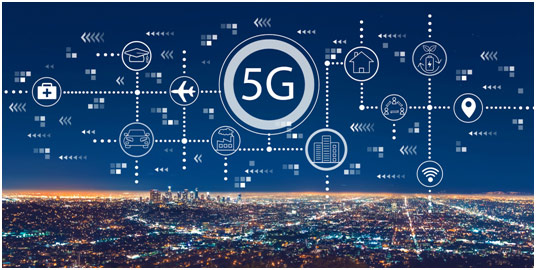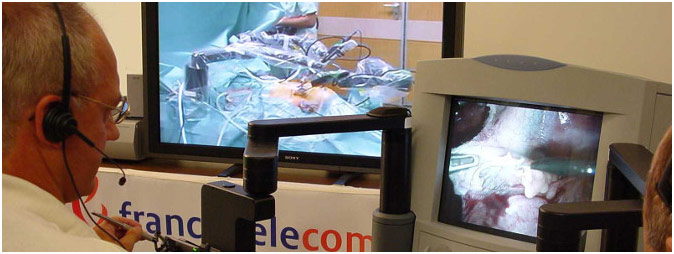5G represents a monumental advance to wireless technology that could not only transform how we connect with one another but also how we live. The most familiar impact of 5G might be in the realm of communication technology as 5G would supplant 4G LTE, taking advantage of new radio frequencies to offer greater speed, bandwidth, and reliability. Furthermore, 5G will reduce latency time, which is defined as the delay between a request being sent to a server and a response being recorded, to near zero. These advances could allow for a universally connected world where self-driving vehicles seamlessly communicate with one another and an expansion of the Internet of Things allows for the creation of truly smart cities. These same revolutionary characteristics of 5G also have direct consequences for medicine, especially when it comes to telehealth.

Extensive Impact of 5G on Society
Perhaps the most immediate application of 5G would be in the realm of telehealth. Telehealth has enjoyed meteoric rise in popularity in large part due to the COVID-19 pandemic as healthcare delivery has had to adapt to the given circumstances. With patients not recommended to leave the safety of their homes, healthcare appointments, from checkups to clinical trial enrollments, have largely moved online, and patients seem to prefer the convenience that an online format affords. On top of convenience, the ability to expand access to care is highly encouraging as a patient with a rare disorder in the most remote part of the world could be treated by a world-renowned expert on that condition sitting across the globe. Where 5G intersects with telehealth is in facilitating this doctor-patient interaction significantly better than 4G can.
As mentioned previously, 5G offers a faster and more reliable connection than 4G does, which will help make telesurgery a reality. In 2001, a procedure termed the Lindbergh operation, after the famous pilot Charles Lindbergh, demonstrated the potential of telesurgery. Dr. Jacques Marescaux performed a robotic cholecystectomy (removal of the gallbladder) with Intuitive Surgical’s ZEUS platform on a patient in France while being physically located across the Atlantic in New York City. This operation was the world’s first telesurgical operation and foreshadowed the immense possibilities of this technology. However, the operation also had debilitating limitations, such as high latency time and no haptic feedback (tactile information). As one can imagine, high latency during surgery can be devastating to the patient as surgery requires making split-second decisions that can make the difference between life or death. Ideally, the latency time should be no more than 100 milliseconds, so even the 155-millisecond latency of the Lindbergh operation was too large a delay. As 5G will take latency time to essentially zero, telesurgical operations will be able to be performed more safely and effectively. Indeed, studies have shown the number of surgical errors to exponentially fall as the latency time decreases. In fact, in 2019, a Chinese surgeon performed neurosurgery on a Parkinson’s patient 1800 miles away using 5G technology.
In addition to reducing latency, a 5G network will be able to make various streams of real-time data available to the surgeon, from heart rate to oxygen saturation. Haptic feedback, now a feature on most surgical robotics devices, provides tactile information that can be transmitted simultaneously with audiovisual streams. On top of that, for complex procedures, experts from various centers can operate with one another in real-time since the network can now handle that connection without an unacceptably high latency. Telesurgery itself offers great benefits, such as allowing an operation to be performed on patients in medically underserved or hostile (i.e., battlefield, space) regions, as well as on those who are too sick to travel. 5G can facilitate telesurgery’s widespread adoption.

The Lindbergh Operation of 2001
Outside of telesurgery, 5G also promises to transform other aspects of telehealth. For instance, 5G technology can be applied in teleambulances. The vision is that paramedics within an ambulance can establish an HD stream of the patient to specialists in a hospital, perhaps through a virtual reality headset. As with telesurgery, the audiovisual data could be supplemented with other streams of clinical data, and a robotic glove could allow a specialist to guide the paramedics’ hand movements to complete an ultrasound scan, for example. With 5G networks, a specialist physician can essentially “be” in the ambulance with the patient. A study found that ambulance telehealth for stroke patients saved about 20 minutes on average because doctors could examine the patients in transit instead of only after they arrived at the hospital. While 20 minutes may seem nominal, in the case of strokes, every minute represents millions of neurons being saved; time is the brain. For patients with less emergent conditions, having a tell ambulance could help a specialist determine if the patient truly needs to come to the hospital or whether the patient’s issue can be patched up by the paramedics or even the specialist remotely. In other words, physicians can get a better understanding of the situation in the ambulance and respond in the most appropriate and efficient manner.
Another aspect of telehealth 5G can impact is the ability to facilitate remote consultations. As telesurgery demonstrated, physicians across various centers can collaborate to take care of a patient more easily. Perhaps more interestingly though, 5G could streamline the sharing of medical imaging. PET and MRI scans are often huge files on the gigabyte magnitude, which means they are often difficult to send and require logging onto a terminal to access. With 5G, these scans could be wirelessly sent to physicians anywhere in the nation, making remote consultations a reality from the convenience of a doctor’s smartphone. Indeed, with healthcare wearable devices becoming increasingly popular and powerful, being able to do everything from performing a one-lead EKG to measure body temperature, we will have a plethora of data at our fingertips, and the ability to continuously transmit it to physicians in real-time will require a network as strong and fast as 5G. Furthermore, as more and more wearable devices communicate with another (i.e., Internet of Things), 5G, which can communicate with a million devices per square kilometer compared to the 100,000 devices of 4G, will be indispensable to creating a digital ecosystem of health.

Inter-Institutional Telehealth Appointment
In facilitating telehealth, 5G promises to expand access to care and transform the healthcare experience for society’s benefit. With stronger, more reliable connections that occur in real time, there are essentially no limits to what can be improved upon in healthcare, from surgery to ambulance transport. Traveling for medical care could become a thing of the past, widespread inter-institutional care a thing of the present. The future of medicine is so exciting in part because it is unknown; the potentials fascinate and inspire us.
REFERENCES
https://www.forbes.com/sites/forbestechcouncil/2019/11/18/the-5g-iot-revolution-is-coming-heres-what-to-expect/#53cf36166abf
https://medicalfuturist.com/5g-in-healthcare-boosting-telehealth-vr-connectedhealth/
https://www.ncbi.nlm.nih.gov/pmc/articles/PMC6067812/
https://www.zdnet.com/article/inside-the-5g-ambulance-that-could-let-doctors-treat-you-miles-from-the-hospital/
https://www.medscape.com/viewarticle/864512
















There is definately a great deal to find out about this topic. I love all the points you have made. Madelyn Sargent June